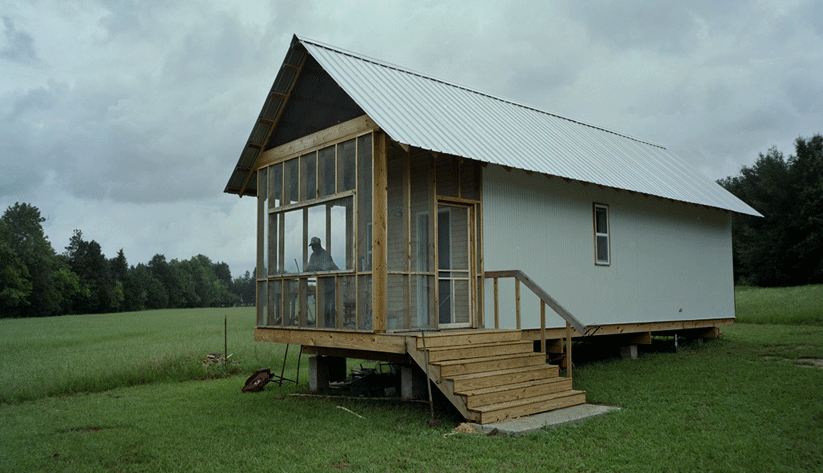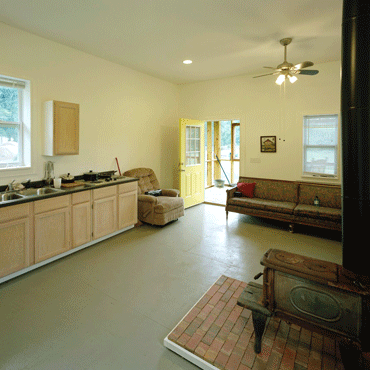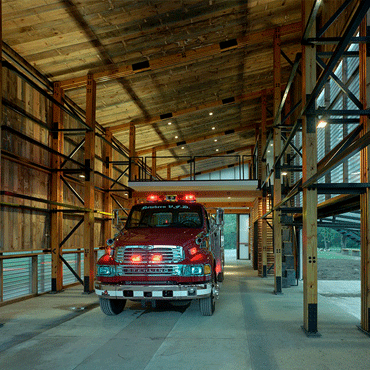
The exterior of Dave’s House. Photo by Timothy Hursley.
At Auburn University’s Rural Studio design program in rural Alabama, students learn the building trade from the ground up.
The Auburn College of Architecture, Design and Construction program allows students to get a hands-on education constructing real homes that benefit an underserved population in West Alabama’s Black Belt region. The architecture students have designed and developed more than 200 homes and community projects for residents in impoverished Hale County since the program began 25 years ago.
Now, as the project partners with Fannie Mae, one of the largest U.S. government-backed mortgage agencies, the students’ designs of small and simple yet functional homes could provide a model for designing efficient, affordable housing in the Southeast and across the country.
From modest beginnings, an idea grew
A few years ago, the Studio launched the 20K Initiative with the goal of constructing a house at a cost of $20,000. Though that figure has increased over time, it still challenges the students to be innovative with designs that conserve energy and are durable and safe. For example, the houses are built on raised platform frames rather than conventional concrete slabs, which can attract moisture and allow termites closer proximity to wooden walls. Produced with locally available wood and materials, the homes for local residents are typically less than 1,000 square feet.
"Our founders felt that access to good, dignified, healthy-built environments should be a right, whether you can afford it or not," said Rusty Smith, the program’s associate director. As a pure charity housing supplier, "we provide houses for people who would not be able to acquire homes on their own."
Undergraduate students enrolled in Auburn’s five-year program have the option to work at Rural Studio, which is based in Newbern, Alabama—about a three-hour drive from the university’s main campus—during their third and fifth years of architecture school.
Working in teams, the students live and work in Newbern, a small town located about 47 miles south of Tuscaloosa. The students raise funds, draw varied designs of a structure, and build mock-ups before formal construction gets under way.
Obstacles inspired creativity
As the program developed, it became clear that rural residents face obstacles that are interrelated, Smith said. There are insecurities around education and wellness, lack of social services and accessible transportation, and constrained government funding and access to credit. To provide more resources for the well-being of the Newbern community, the students designed and built a library, community center, fire station, and health-care facility. The students have the help of consultants in engineering, landscaping, and general building. The architecture program also consults medical insurers and groups that study indoor air quality to gain insight into how to design a home that provides a healthy environment. Relationships with lenders like Regions Bank, an early investor in the 20K Initiative, promote understanding about affordable home financing.
"It is a tough, complex problem with housing affordability in rural markets," Smith said. "We don’t have the power to address or change all those issues. But we work with partners who can."
The homes Rural Studio builds are often named after the residents who receive them. Dave’s House, completed in 2009, is a form of shotgun home that includes a screened front porch. It has one bedroom, one bathroom, and a large, open living space.

The interior of Dave’s House. Photo by Timothy Hursley.
"The goal is to create a safe, cost-effective but also well-designed, aesthetically pleasing house," said Ann Carpenter, senior adviser on the Atlanta Fed’s Community and Economic Development team.
She said the holistic approach of the program, which also—addresses the needs of the community, makes Rural Studio unique. For instance, the students constructed a two-story fire station that helped lower residents’ insurance costs by providing local fire protection, she said. The fire station can withstand winds of 110 mph and has a thermal mass concrete floor that helps heat the station at night, ensuring the water tanks don’t freeze.
The Newbern fire station. Photo by Timothy Hursley.
"They’ve thought realistically about all aspects of housing costs," Carpenter added.
A few years ago, Rural Studio collaborated with a building contractor in Georgia to build two small houses in Serenbe, a wellness community just outside Atlanta. Those houses are now used as artist cottages.
Broadening the concept
Earlier this year, Rural Studio announced a three-year program with mortgage lender Fannie Mae that will collaborate with the federal departments of agriculture and energy, other mortgage lenders, and home insurers to develop a blueprint for lower-cost homes that promote sustainable rural living. The partnership is developing resource guides to equip building industry providers with house plans and advice that can be tailored to other markets not only in the Southeast but nationwide. Fannie Mae is supporting the project as part of its Duty to Serve mandate, which requires improving access to affordable housing in underserved areas.
"There’s just not enough affordable housing being created," said Michael Hernandez, vice president at Fannie Mae with responsibility for housing access. "With rising costs of construction and land and now interest rates moving up—all of those factors are having increasing impacts on families’ ability to purchase a home," he said.
At the end of the three years, partners such as Habitat for Humanity and other builders will be delivering affordable houses based on the Rural Studio models beyond Alabama, whether for charitable, subsidized, or for-profit use, Smith said.
Hernandez says Fannie Mae embraced Rural Studio because of the need to support technologies that can lower costs and bring more efficiency to housing. "The homes are built to be reflective of the local market, but the engineering and design that goes into them is amazing," Hernandez said. For instance, high ceilings and the design of doors and windows give the Rural Studio houses a spacious feel despite their smaller square footage, he said. The houses are also built to hold up to strong winds and hurricanes—a real risk in the Southeast.

The Atlanta Fed’s Ann Carpenter
Already, Fannie Mae has helped Rural Studio form relationships with other groups nationwide that have an interest in affordable housing, Hernandez said. "We get their knowledge and learning, and they get the opportunity to benefit from our relationships and activities across the country," he added.
Hernandez noted that markets farther west are studying the small Rural Studio houses to see if they might work as in-fill housing or accessory dwelling units—sometimes known as "granny flats"—that could be placed on larger lots. "Our real hope is that other builders and not-for-profits across the country will embrace these designs and begin to implement them," Hernandez added.
Fannie Mae is promoting affordable housing in other ways, Hernandez said. For instance, in the past year, the housing agency launched a mortgage program for the financing of manufactured homes that meet specific standards similar to those used for site-built homes. For example, the manufactured houses feature higher-pitched roofs, open floor plans, garages, porches, and durable materials. The mortgage product "challenges the industry to build a manufactured home that really resembles a stick-built home and can fit into many communities seamlessly at almost half the cost," Hernandez said.




